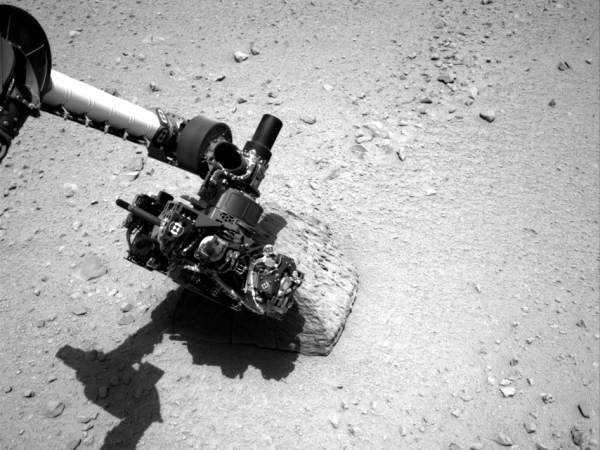The robotic arm of NASA’s Curiosity rover recently made contact with a Martian rock for the first time – analyzing the chemical elements inside of a rock dubbed “Jake Matijevic” by scientists.
After a short drive to reach the football-size rock, Curiosity moved its Alpha Particle X-Ray Spectrometer (APXS) instrument to examine the rock during the rover’s 46th Martian day, or sol.
The APXS is on a turret at the end of the rover’s 7-foot (2.1-meter) arm. The Mars Hand Lens Imager (MAHLI), on the same turret, was used for close-up inspection of the rock.
The Chemistry and Camera (ChemCam) instrument, which shoots laser pulses at a target from the top of Curiosity’s mast, was also activated. Using both APXS and ChemCam on the rock provided a cross calibration of the two instruments.
With a final ChemCam laser testing of the rock on Sol 48 (Sept. 24), Curiosity finished its work on Jake Matijevic. The rover departed the same sol, with a drive of about 138 feet (42 meters), its longest yet. Sol 48, in Mars local mean solar time at Gale Crater, ended at 3:09 p.m. Sept. 24, PDT.
Curiosity is currently en route to a site known as Glenelg, which is located approximately 1,300 feet (400 m) from the rover’s touchdown site. Glenelg was initially selected as a destination because three different types of terrain are found there close together. It’s been chosen as a likely place to find multiple rock targets for drilling and analysis.

The light-toned area is particularly intriguing, as it retains daytime heat long into the night, suggesting an unusual composition.
“As we’re getting closer to the light-toned area, we see thin, dark bands of unknown origin,” says MSL project scientist John Grotzinger of the California Institute of Technology. “The smaller-scale diversity is becoming more evident as we get closer, providing more potential targets for investigation.”
Recent images from the rover’s camera reveal dark streaks on rocks in the Glenelg area that have got the researchers rather excited.
Curiosity landed on Mars seven weeks ago to begin a two-year mission using 10 instruments to assess whether a carefully chosen study area inside Gale Crater has ever offered environmental conditions favorable for microbial life.






